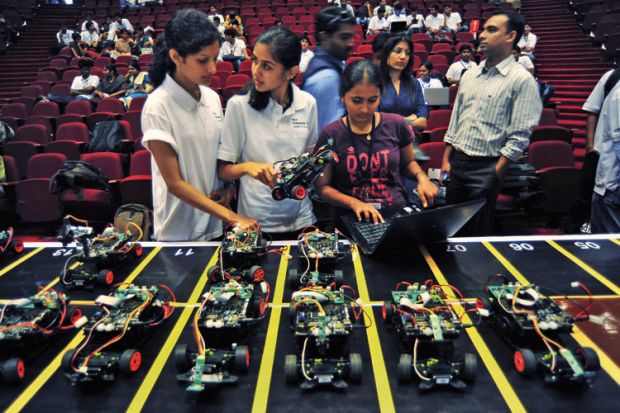View the full results of the BRICS & Emerging Economies Rankings 2016
The Indian higher education system is vast, fascinating and full of energy. At 25 million, its student population is the world’s second largest after China. But the entire sector, both public and private, is highly fragmented, and over-regulation has had little positive impact on quality.
Of late the sector has experienced very rapid growth, spurred by the prospect of well-paid graduate jobs in the private sector. Although critics lament the poor quality of education, private institutions have developed a frugal model to deliver education at a relatively low cost, with running costs met entirely from tuition fee income. Public universities are better funded, generally have low tuition fees and, by and large, attract the better students. Only a minority of institutions offer research and postgraduate education.
In this vast array of universities, one group of very special institutions stands out: the Indian Institutes of Technology. Conceived in 1946, a year prior to Indian independence from British rule, the blueprint for the institutes was prepared by the Sarkar Committee, composed of leading academics and scientists, industrialists and government officials. In 1961 the Institutes of Technology Act was passed by the Indian Parliament, with many of the committee’s recommendations enshrined in law.
Between 1951 and 1960, five IITs were set up across the country, and within two to three decades the model gained national and international acclaim, primarily as a result of the achievements of IIT alumni. Strong public demand for an IIT education has resulted in the setting up of 13 more institutes.
The institutes have several unique features. The Joint Entrance Examination, which tests physics, chemistry and mathematics and is open to foreign as well as Indian students, is the only route for admission to undergraduate engineering programmes. Nearly all students and faculty live on campus, allowing for flexibility in working hours. At IIT Bombay, there is a 6.30pm to 8pm slot for lectures and many students use the laboratories after office hours. There are also excellent facilities for extracurricular activities.
In the past two decades, major changes in the institutes have led to their being recognised as among the world’s leading universities, particularly in engineering and technology. Below, I highlight some of the major trends for IIT Bombay, noting that similar narratives exist for other institutes.
Undergraduate numbers at IIT Bombay have risen by more than 70 per cent in seven years. Graduate numbers have grown even faster, with this cohort now making up more than 50 per cent of the student population. More than 200 faculty members with excellent academic credentials have been recruited, research funding has grown fivefold in this period and research facilities have improved. The institute has diversified, with strong graduate programmes in disciplines ranging from social sciences to climate change studies, and an undergraduate programme in design launched this year.
IIT Bombay has begun to engage strongly with industry in India and abroad, and now does business with 350 firms a year. An example is the National Centre for Aerospace Innovation and Research, funded by Boeing Corporation and the Department of Science and Technology. A large number of other companies also support the work of the centre, which has 14 staff and 63 research students.
Partnerships with international universities have also strengthened, and include a joint PhD programme with Monash University, with some 100 academics in each institution jointly advising a cohort of 170 students.
Student and faculty interest in entrepreneurship has grown and the institute has several initiatives to encourage them. The Society for Innovation and Entrepreneurship is IIT Bombay’s technology business incubator; the Desai Sethi Centre for Entrepreneurship runs courses and workshops for students interested in starting businesses; and E-Cell is a student club focused on entrepreneurship. Powai, the locality around IIT Bombay, is a growing ecosystem for start-ups.
IIT Bombay is committed to providing a modern, flexible and high-calibre education, creating a vibrant and open environment for student growth and carrying out research that makes a difference – to the field, to industry and to society as a whole.
Devang Khakhar
Director, Indian Institute of Technology Bombay
POSTSCRIPT:
Print headline: Blueprint for excellence
Register to continue
Why register?
- Registration is free and only takes a moment
- Once registered, you can read 3 articles a month
- Sign up for our newsletter
Subscribe
Or subscribe for unlimited access to:
- Unlimited access to news, views, insights & reviews
- Digital editions
- Digital access to THE’s university and college rankings analysis
Already registered or a current subscriber? Login




